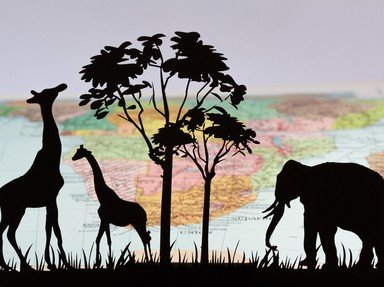Quiz Answer Key and Fun Facts
1. Due to its size, the stuffed toy replication of this magnificent creature is often very large. The original is divided into two basic species, both of which live in Africa and are critically endangered. They are land-dwelling animals that are mostly fur covered with bare patches on their faces and chests, depending on the sub species. They are primarily herbivores, although insects such as termites and ants are also part of their diet. What animal is this?
2. These large rodents (second largest in the world) are native to North America and Eurasia. They are semi-aquatic, building their homes, called lodges, with underwater access. That's not the only thing these busy creatures build. Cuddly versions often emphasize their prominent teeth. What are they?
3. This animal makes a perfect stuffed animal because it looks as cuddly in real life as it does as a toy. It has very distinctive colouring and a very specific diet which it can be seen eating while lying down. Which creature is this, that looks like it has a pair of black eyes?
4. My daughter's very first stuffed toy was given to her when she was one day old. It was designed to look like an African animal with long legs, small horns and a prehensile tongue. It also has a pretty specific diet. What ungulate ruminant is this?
5. This wading bird can be found in the Americas and in parts of Europe, Asia and Africa. Plastic versions have been known to decorate front lawns. If I say pink, I bet you'll know what I mean. Which bird is this?
6. This domesticated animal comes in all different sizes and colours, as does the stuffed animal that is designed on it. There are, however, definite commonalities between different breeds, including whiskers and, usually, an expressive tail. Which animal is this, that was once worshipped and mummified by ancient Egyptians?
7. This large marsupial (standing as tall as 6 ½ feet or 2 metres) is from Australia and is so representative of the country that it is on the country's coat of arms. Its unique appearance, standing upright on two very large feet with a long, powerful tail, makes it an ideal candidate to be reproduced as a stuffed animal for children to cuddle. What animal is this?
8. This large mammal can be found across parts of Africa, Southern Asia and Southeast Asian. Long time favourites of children, stories about and stuffed versions of these creatures have been around for years. What animal that can't jump, the largest land animal, is this ?
9. This large predator is the largest of the big cats. Its tendency to be a solitary animal coupled with its natural territory being among densely populated areas of the world has created problems with habitat and conflict with human beings. What furry animal is this, that has been reproduced as a stuffed toy?
10. This small mammal can be found in most, although not all, parts of the world. They come in many varieties and colours and the stuffed version is particularly popular at Easter, although they can be found in stores at Christmas. What animal is this?
Source: Author
skunkee
This quiz was reviewed by FunTrivia editor
agony before going online.
Any errors found in FunTrivia content are routinely corrected through our feedback system.
